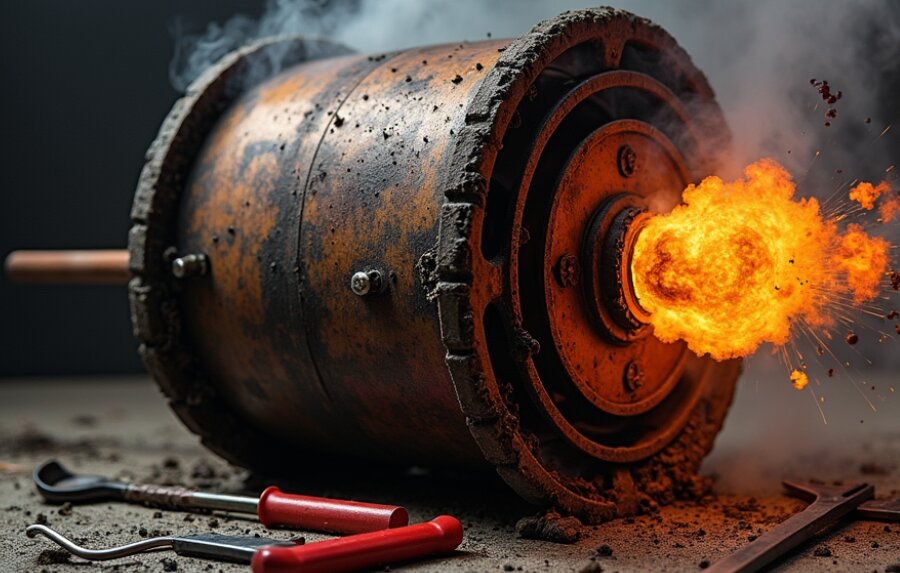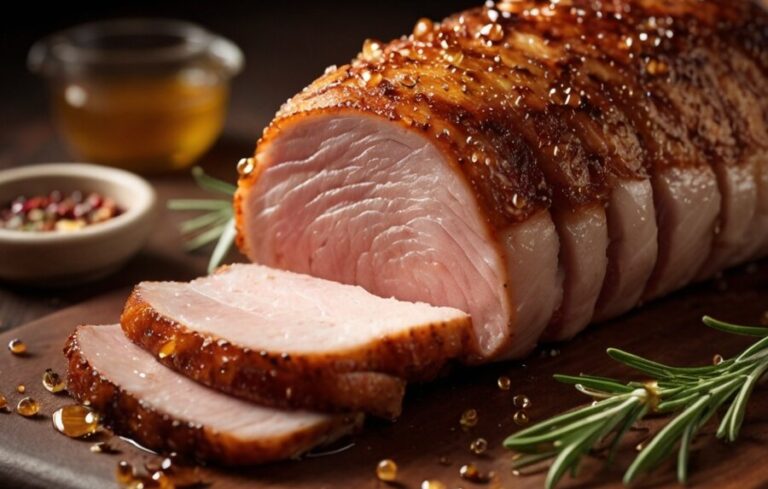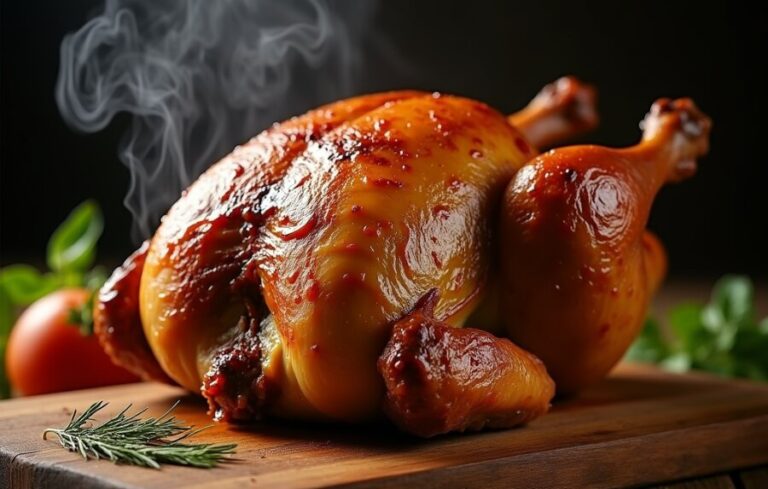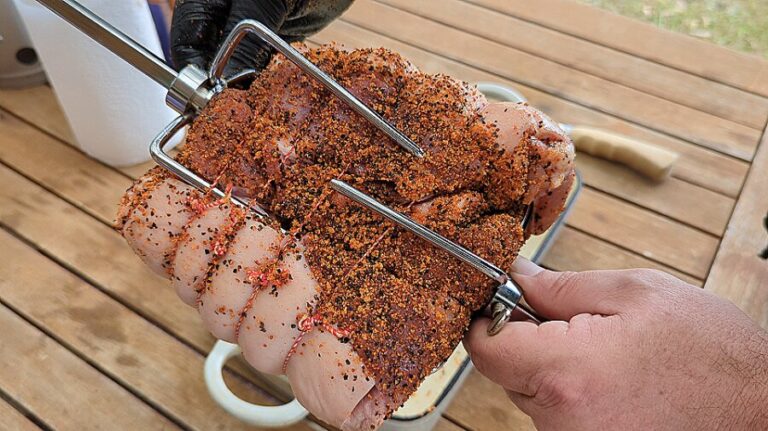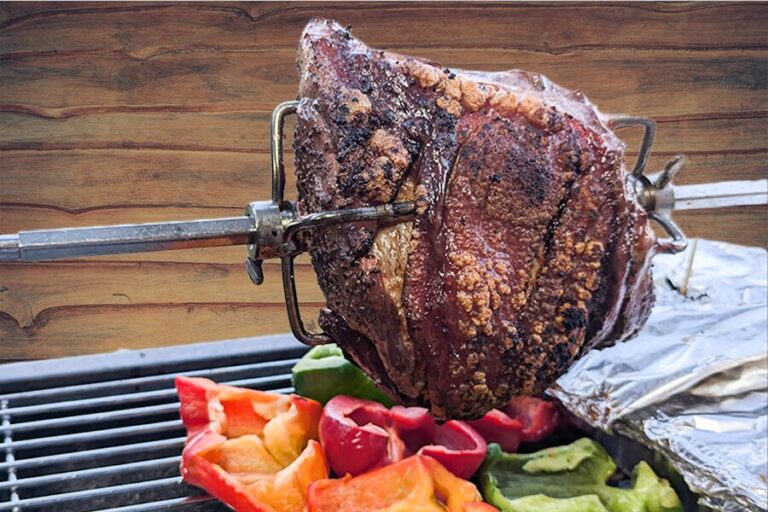Our evaluations and product assessments are conducted using a thorough and unbiased approach. Should you choose to buy any items through our provided links, we might receive a commission Read our disclosures.
Troubleshooting Your Rotisserie Motor Problems
Is your Rotisserie Motor Not Turning? It’s time to roll up your sleeves and fix the issue. Here’s how I get things spinning smoothly again.
Aligning the Spit Rod and Motor
One common snag is a misaligned spit rod. If the spit rod isn’t lined up right, the motor can throw a fit and refuse to turn. To sort this out, I double-check that the spit rod is properly seated in the motor and straight as an arrow. If I spot any bends or weird angles, I reposition until everything clicks into place.
Balancing Weight Distribution
Another thing to watch out for is how the weight’s distributed along the spit rod. Trust me, an unbalanced load can make the motor grind to a halt. I make sure the food’s weight is spread out evenly on the rod. If I’m roasting something super heavy, I might use a counterbalance to ease the load. This ensures my motor isn’t straining like a gym newbie.
JustAnswer has some good advice too: overloading the motor can make it stop dead. Some high-quality motors, like the Onlyfire Universal Grill Electric Replacement Rotisserie Motor, can take on serious heft without breaking a sweat. I always check the motor’s weight limit before piling on the meat.
Inspecting the Spit Rod and Motor
Lastly, regular inspections keep things in tip-top shape. Frayed cords or bent rods are like red flags; they’ll mess up your cooking in no time. I look over both the spit rod and motor for any wear and tear and swap out any damaged parts pronto. Keeping everything shipshape means fewer headaches later.
With these steps of aligning, balancing, and inspecting, I usually get my rotisserie motor back in action quick. Then I can kick back and enjoy my BBQ adventures! For more grilling tips, check out my articles on rotisserie flare-ups and uneven browning.
Common Rotisserie Problems
Rotisserie cooking can be a delicious adventure, but let’s face it, even the best setups hit a snag sometimes. Here are some common issues I’ve run into and how you can fix them, focusing on power supply problems, heating elements, and the all-critical timer/thermostat/switch combos.
Power Cord Malfunction
Ah, the trusty power cord. When my rotisserie motor decides it’s taking a day off, I always check the power cord first. Loose connections, frayed wires, or a janky plug can mess with the mojo. Here’s a quick rundown:
| Problem | Clues |
|---|---|
| Loose Connections | No motor action |
| Frayed Wires | Sparks or zip, zilch, nada |
| Faulty Plug | Power that’s there, then not |
Heating Element Issues
Ever cooked a chicken that was half golden brown and half ghostly pale? Blame the heating element. If the rotisserie isn’t heating properly or cooking unevenly, it’s often the culprit. Here’s what to look out for:
| Sign | Fix |
|---|---|
| Uneven cooking | Possibly busted heating element |
| No heat | Check connections and the element itself |
Timer, Thermostat, and Switch Concerns
Timers, thermostats, and switches—these tiny critters can either make your rotisserie game flawless or totally frustrate you. If your cook times are whack or the motor’s acting flaky, the problem might lie here:
| Component | Symptom | What to Do |
|---|---|---|
| Timer | Wonky cooking duration | Reset or replace it |
| Thermostat | Temperature out of whack | Test and swap if needed |
| Switch | On-again, off-again issues | Continuity test and replace if it’s shot |
For more troubleshooting fun, check out my articles on rotisserie flare-ups and burner problems. With a bit of patience and some elbow grease, you can conquer most rotisserie problems and turn out tasty results every time.

Keeping Your Rotisserie in Prime Cooking Shape
Owning a rotisserie isn’t just about cooking delicious meals; it’s also about maintaining your gear to keep it running smoothly. Let’s dig into some insider tips to keep your rotisserie in tip-top condition and avoid problems like that pesky motor not turning.
Post-Cooking Cleanup
I’ve found that tackling cleanup right after cooking makes everything much simpler. Here’s my quick and easy routine to keep things spotless and working:
- Unplug and Cool Down: Safety first, always.
- Disassemble the Gear: Take out the spit rod and whatever else you’ve used.
- Scrub Time: Use warm soapy water and a soft cloth to clean the spit rod, forks, and any other removable bits.
- Wipe the Motor Housing: Got to keep the motor free from grease and grit.
- Rinse and Dry: Dry everything thoroughly before putting it all back together.
Trust me, it only takes a few minutes but saves a lot of headaches down the line.
| Step | Why It Matters |
|---|---|
| Unplug | Avoid accidental shocks |
| Disassemble | Easier scrubbing |
| Soapy Scrub | Fights grease and germs |
| Dry Everything | Banish rust forever |
For more clean-up hacks like fixing flare-ups, check out our guide on troubleshooting rotisserie flare-ups.
Keeping Electrical Parts Zap-Free
Nobody likes dealing with a broken motor. Here’s how I keep my electrical parts in good health:
- Power Cord Checks: Regularly inspect the cord for any wear and tear. Replace immediately if it looks sketchy.
- Mind the Weight: Don’t overload the motor. My go-to is the Onlyfire Universal Grill Electric Replacement Rotisserie Motor—it handles heavy loads like a champ, but let’s not push it (Amazon).
- Perfect Positioning: Make sure the motor aligns just right to avoid any added stress.
Stick to these habits, and you’ll avoid those nasty surprises that could ruin a good cookout.
For more tips on cooking perfection, like preventing your meat from drying out or how to deal with uneven browning, check out why your meat’s drying out and fixing uneven browning.
Making the Most Out of Manufacturer Resources
Check Out the Owner’s Manual
So, your rotisserie motor isn’t turning? Before you start tearing your hair out, grab that trusty owner’s manual. This little booklet is a goldmine of info. It’s packed with tips and tricks for troubleshooting, parts details, and the all-important warranty scoop. Tossing it out would be a rookie mistake—it’s your best friend in keeping that appliance in top shape (Fix-It Club).
Here’s a cheat sheet of what you’ll typically find:
| Section | Content |
|---|---|
| Troubleshooting | Common hiccups and how to fix ’em |
| Parts Info | List and details of parts you might need to swap |
| Warranty Details | Everything about the warranty coverage |
| Operating Instructions | How to use it right and stay safe |
On the Hunt for Replacement Parts
Figured out you need a new part? Time to go shopping. The manufacturer’s website is usually a good start, but reliable aftermarket options are also out there. You might need anything from a new motor to some gears—whatever it takes to get that rotisserie twirling again.
Here’s the toolkit I keep handy:
| Tool | Purpose |
|---|---|
| Screwdriver | Popping out and securing screws |
| Pliers | Grabbing and twisting things |
| Replacement Parts | Specific bits that need swapping |
Always compare prices and quality before hitting ‘Buy Now’. Want more tips? Check out the DIY guides on dealing with rotisserie flare-ups or tackling uneven browning. These resources will help you fine-tune the operation and upkeep of your rotisserie.
Customer Reviews and Insights
Listening to other outdoor cooking fans provides loads of wisdom on how rotisserie motors fair in everyday use. From what I’ve gathered, feedback from real users offers a goldmine of information on performance and reliability.
What Folks Are Saying
Most people are pretty happy with their rotisserie motors. They mention that the devices work like a charm, are well-built, and easy to use. However, some find the size and installation process a bit tricky. Here’s what customers are talking about:
| Praise | Complaints |
|---|---|
| Super functional and well-made | Some issues with size |
| Works like a champ under load | Installing it can be a hassle |
| Quiet compared to others | Strength of the motor varies |
A standout favorite is the Onlyfire Universal Grill Electric Replacement Rotisserie Motor. Users rave that it’s super efficient, handling hefty loads without breaking a sweat.
Durability and Performance
When it comes to lasting power, the Onlyfire motor seems to be killing it. Many folks love its quiet operation and sturdy build. It’s a solid choice for those serious about their rotisserie game. Here’s the scoop:
| Aspect | What They Say |
|---|---|
| Noise Level | “Super quiet compared to other motors.” |
| Build Quality | “Feels like it’s built to last.” |
| Weight Capacity | “Handles heavy stuff with no sweat.” |
Fans of the Onlyfire motor note it’s a quiet replacement for noisier options like the Weber motor. Feedback on its strength is pretty consistent, with folks saying it holds up well even when put to the test.
Understanding others’ experiences helps me make smart choices, especially if I run into hiccups like my rotisserie motor not turning. For more troubleshooting tips, checking out rotisserie flare-ups and burner issues is super useful.
Getting Your Rotisserie Motor Up and Running
Got a rotisserie setup waiting to roast some delicious grub? Let’s talk about making the motor work its magic. The good news? It’s pretty straightforward-some might even call it foolproof.
Easy-Peasy Installation
Putting a rotisserie motor in place shouldn’t make you break a sweat. I’ve done it myself and trust me, motors like the Onlyfire replacement are designed for even the least tech-savvy among us. This model is all about simplicity (Amazon).
Let’s break it down:
- Ditch the Old Motor: First, say goodbye to your old motor.
- Position the New One: Slide the new motor into the mounting bracket.
- Wire Up: Make sure all the electrical connections are snug and safe.
- Test Run: Give it a quick spin before you start cooking to make sure it works.
Most folks find these steps a breeze, so you should be up and running in no time.
Smooth Sailing Once Installed
Once your motor’s in place, the fun really begins. My experience with the Onlyfire motor has been top-notch. It performs like a champ, rotating food evenly to get that perfect golden-brown finish. This motor can handle serious weight without breaking a sweat (Amazon).
Here’s what other users have to say:
| Feature | Comments |
|---|---|
| Power | Can handle hefty chunks of meat |
| Efficiency | Spins food for even cooking |
| Noise | Quiet operation – the sound of silence! |
| Build | Strong and durable |
These perks make your rotisserie more than just a cooking tool-it becomes the star of your outdoor grilling.
To make sure you’re getting the most out of your setup, you might want to check out some handy tips like troubleshooting rotisserie flare-ups or dealing with rotisserie meat drying out. These bits of advice can turn a good cookout into a great one.


